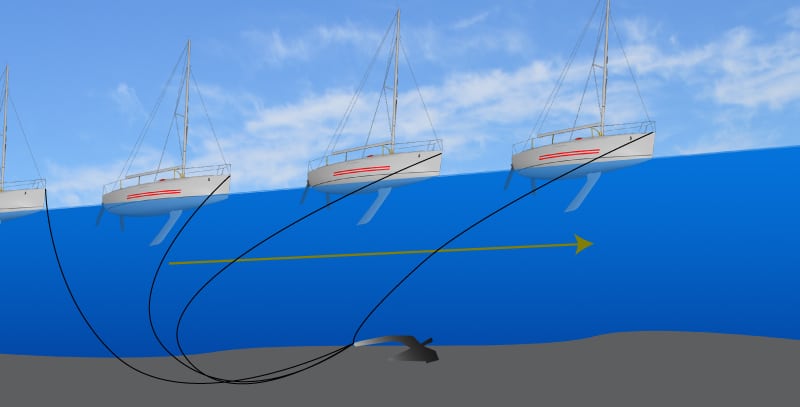
This article is an excerpt from NauticEd’s online Skipper Large Keelboats Course, a comprehensive online sailing course for beginner to intermediate sailors to learn how to sail large sailboats 26 ft (8m) and above. The Skipper Large Keelboats course is part of the Skipper Course Bundle of online courses, also teaching you how to master maneuvering under power and docking!
You can learn to sail and improve your sailing with NauticEd, the international leader in sailing education.
Weighing Anchor
“Weighing the anchor” simply means raising it.
With an Engine
If raising the anchor is to be done by hand, make certain the assigned crew who will pull in the rode and raise the anchor are physically able. This can be a demanding chore.
When the time comes to leave an anchorage, there are recommended procedures.
Step One: Ensure all gear is properly stored and crew and passengers know what is going on. Ensure you have an agreed-upon set of hand signals between the crew member who is retrieving the anchor and the helmsperson.
Step Two: Start the engine and slowly motor toward the anchor, all the while pulling in the rode and placing it carefully in the anchor locker. Do not let the rode drift under the vessel as it could become entangled in the propeller, creating some real problems.
Step Three:
Plan A: As the vessel moves over the spot where the anchor rests, pull it up if you can. Stop the vessel’s forward motion as you continue pulling in the anchor. If you use an electric windlass to raise the anchor, be vigilant to ensure it is running freely.
Plan B: If the anchor is set hard and you cannot pull it in, you may need to use the vessel’s forward motion to break the anchor loose. This means maintaining a slight forward motion and cleating the rode as you pass over the spot. The theory is that the vessel’s momentum will break loose the anchor. Be very wary of the strength of the cleat on your boat.
Plan C: If the anchor fails to break loose, perhaps it’s stuck on a rock. You can try to pull it out backward by motoring to windward. The flatter the angle you are pulling, the greater the chance of retrieval, so let out lots of rode when motoring to windward. Be conscious of the rode and propeller at all times.
Plan D: Try pulling the anchor out sideways. Let out lots of rode and alternate motoring across the wind on either side.

Weighing Anchor
Plan E: Persistence and various combinations of the above will normally work in your favor.
Tip: If you don’t have a windlass and you’re feeling a little tired, you can run the rode back to one of the winches atop the cabin.
Watch out that you’re not stuck on a boat dock cable from a marina. In lakes, you might often be stuck on an old tree stump.
A variety of other techniques can be used when anchoring in rocky bottoms. One is attaching a line and a float to the backside of the anchor making it possible to pull the anchor out backward. However, this requires preplanning. If you’re unsure of the bottom then this might be a safety precaution.
The Anchor Rescue Device: is an ingenious device that can save the day. You have to prepare for it however by purchasing the device and attaching it to your anchor. Watch the video below.
Anchor Rescue
The very worst scenario is that you will have to leave the anchor and rode for later recovery with a dive professional. In this case, don’t cut the rope rode, pay it all out and attach a floating bottle, such as a Clorox bottle, to the bitter end of the rode. If you do cut the rope, keep in mind that you will need to buy another complete rode, which is not cheap.
The best advice when weighing anchor is to remain calm and thoroughly think through your procedures before using them.
The possibility of losing an anchor to the bottom always exists. This helps underscore the need to carry an extra anchor and rode for just such an unfortunate occasion.
Without an Engine
At times, you may desire or need to retrieve the anchor without using the engine. In this case, use the forward momentum of the boat rather than fighting the tension in the anchor rode. Pull the rode enough to get the boat moving forward; once the boat is moving, it will tend to continue moving forward and the rode will slacken allowing you to pull in some more. Simple patience will save a lot of grunting and groaning.
You can learn more in the Skipper Course....
Knowledge and theory for longer distances and overnight sailing in diverse conditions. The Skipper Course is a comprehensive online sailing course for beginner to intermediate sailors wanting to learn how to sail larger sailboats 26ft to 56ft. Or upgrade to the Skipper Course Bundle of online courses to also master maneuvering under power and docking!
